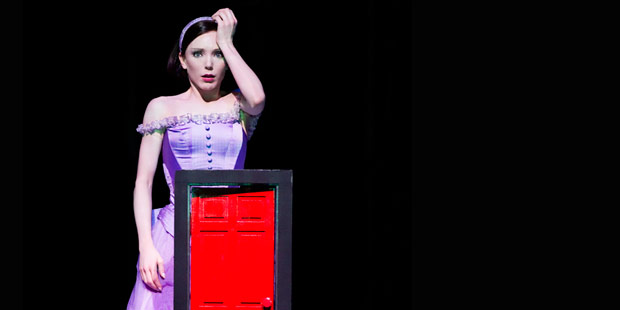
© Johan Persson, courtesy the Royal Opera House. (Click image for larger version)
Royal Ballet
Alice’s Adventures in Wonderland
London, Royal Opera House
6 December 2014
Gallery of pictures by Dave Morgan
www.roh.org.uk
There are parallel universes in Christopher Wheeldon’s Alice, even more curious than those in Lewis Carroll’s storybook for children. He wrote of 10-year old Alice Liddell having ‘a dream within a dream’ during a day on the river; Wheeldon’s teenager experiences a double time-warp from 1862 to the present.
The ballet opens with a Victorian garden party in Oxford. Alice’s father, Henry Liddell, Dean of Christ Church, has invited local eccentrics, including Lewis Carroll, who will reappear as characters in Alice’s fantasy world: so will her temperamental mother. Pay attention from the start – and read Nicholas Wright’s synopsis in advance – if you hope to keep in touch with the adapted story.
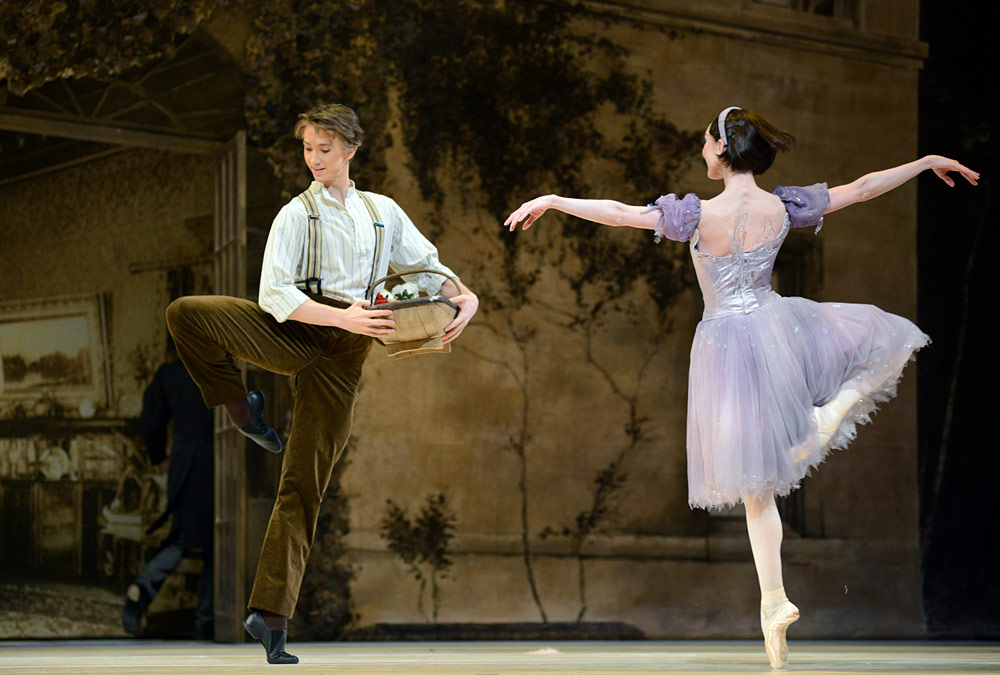
© Dave Morgan, courtesy the Royal Opera House. (Click image for larger version)
Although servants dance alongside invited guests in the garden, a class distinction is enforced by Mrs Liddell, who dismisses Jack, the gardener’s boy, for being over-friendly with her daughter. Lewis Carroll consoles distressed Alice by taking her on a magical underground journey in search of Jack. Her surreal adventures therefore have a purpose, as well as fulfilling the usual balletic rite-of-passage to maturity for the young heroine. Originally in two acts, the ballet was made into three at last year’s revival.
During Act I, as Alice undergoes bewildering changes of size, she peers through a keyhole and sees us, a modern-day audience watching her, as a bevy of be-tutu-ed flowers rushes down the aisles towards her. They represent the garden (of Eden?) from which she is excluded; we spectators are her glimpse of the future, which will become the present at the very end of the ballet. Scary stuff.

© Johan Persson, courtesy the Royal Opera House. (Click image for larger version)
The difficulty that the choreographer and dancer face is Alice’s age. She has to be juvenile enough to be intrigued by the random episodes in which she is a bystander, and yet old enough for a love interest. Wheeldon has given her contrasting steps in which she takes ungainly positions with flexed feet, including stomping around childishly, combined with elegant arabesques and sophisticated spins. Her signature swishes with her legs are up and down, back and forth, with a mulish kick to the ground. Sarah Lamb in the first cast is gamine, decisive and eager to fall in love.
Vadim Muntagirov, making his debut as Jack, is any girl’s dream of a dancing partner. With a boyish new haircut, he looks both naïve and noble, putting aside his persecution as the Knave of Hearts in order to concentrate on Alice. (Why on earth handicap a dancer with a jacket that rides up around his neck?) Their pas de deux are now threaded through the action, so we see more of Jack during the ballet than simply a Knave on the run.
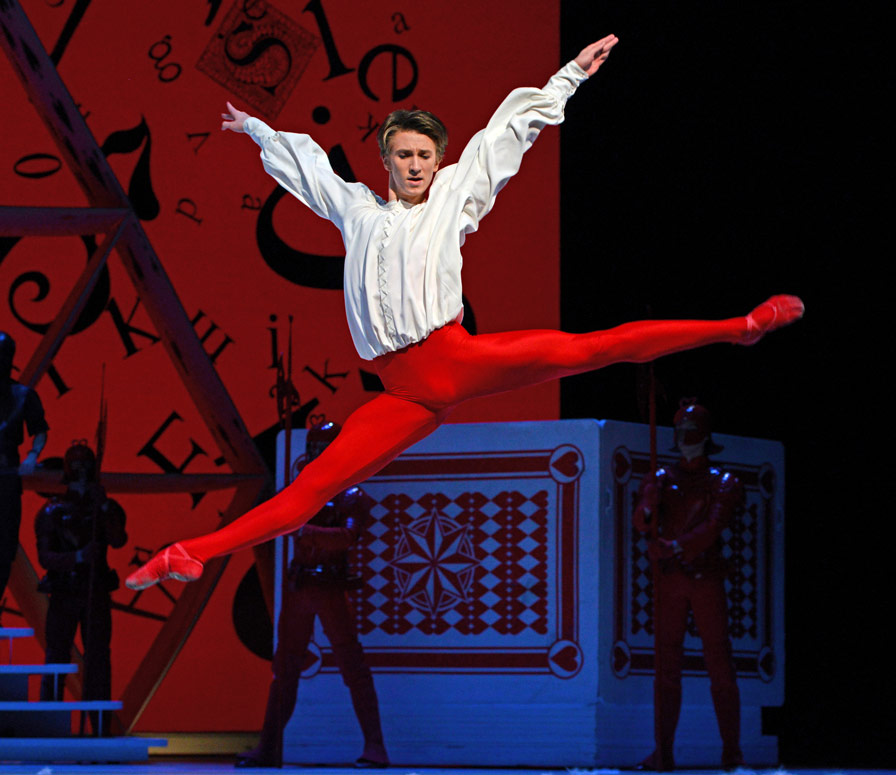
© Dave Morgan, courtesy the Royal Opera House. (Click image for larger version)
Their encounters are skilfully arranged to appear youthfully playful rather than erotic. Alice repeats her quicksilver moves, flying upwards under his control. She no longer has to make up her mind where she wants to go or what she feels; she’s found what she wants. She has already expressed her search for identity in a questing solo in Act II. Jack has his big solo near the end of Act III, protesting his innocence and ardour. Muntagirov dances it as he did Des Grieux in Manon: he takes command of the stage, vulnerable and irresistible.

© Dave Morgan, courtesy the Royal Opera House. (Click image for larger version)
Wheeldon is at his best in those elements of the ballet that have little to do with the original tale: the love story and big ensembles for the waltz of the flowers in Act II and the pack of cards in Act III. He is greatly helped by Joby Talbot’s score, which becomes delirious with excitement, channelling Tchaikovsky or Prokofiev. The music also spells out what Alice must be feeling during her journey, since in the theatre most of the audience can’t see her facial expressions. It’s often not clear in Act I whether she is frightened, lonely, bewildered or just resolute.
The only time she cries, her tears of frustration result in the weakest scene in the ballet: the flood of inexplicable characters (unless you remember the book) who then dry out in a pointless caucus race. The episode doesn’t work with a grown-up Alice who lacks the original child’s sulky indignation at adults’ irrational behaviour.

© Dave Morgan, courtesy the Royal Opera House. (Click image for larger version)
The first two acts are bound to be incoherent because the tones of each set-piece taken from the book shift between puzzling — the caucus race, the Mad Hatter’s tap dance – to charming – The Sleeping Beauty panorama behind a paper boat – and horrifying. The Sweeney Todd kitchen behind a twee Home Sweet Home sampler is suddenly a Victorian nightmare. What are we to make of Alice’s sense of responsibility for the baby whose fate is to be turned into a string of sausages? The violence of the blade-wielding cook (demented Kristen McNally) does at least prepare us for Michael Stojko’s fiendish executioner, prepared to obey the Red Queen’s commands to ‘Cut off their heads’.

© Johan Persson, courtesy the Royal Opera House. (Click image for larger version)
The Oriental Caterpillar (Eric Underwood) who drugs Alice with an hallucinogenic mushroom is one of those alarmingly attractive ballet villains who could seduce the heroine into his harem. Wheeldon has fun referring to many ballets – La Bayadère, Le Corsaire, The Prince of the Pagodas, Checkmate, Jeux de Cartes, The Nutcracker – while keeping his own choreographic stamp on the proceedings. He’s entertaining the balletomanes while charming children (and everyone) with the shape-shifting Cheshire Cat.

© Johan Persson, courtesy the Royal Opera House. (Click image for larger version)
Thanks to Zenaida Yanowsky’s gift for comedy, the parody of the Red Queen as Aurora in Act III succeeds in being outrageously funny. Yanowsky starts out in the Deanery as trouble-stirrer Natalia Petrovna from A Month in the Country and develops into a monstrous juggernaut with a rose fixation. Philip Mosley’s complacently vicious Duchess has no chance against her. All the characterisations are formidable in this revival, retaining traces of their earlier ‘normal’ roles as garden party visitors.

© Dave Morgan, courtesy the Royal Opera House. (Click image for larger version)
The finale is a tour de force in which characters and their musical motifs from earlier scenes are reprised in the mayhem of the Knave’s trial. The whole edifice collapses like the house of cards it is, as ephemeral as its projected theatrical effects. A back-to-the-future coda takes us to the present, with Alice and Jack as modern youngsters. A stranger picks up the book they’ve left behind and becomes immersed in it, twitching like the White Rabbit. Lewis Carroll/Charles Dodgson’s gift renews itself with every generation. Wheeldon’s ballet may not prove quite so enduring, but it is the best translation so far of a word-play classic into a non-verbal dance-drama for audiences of all ages.













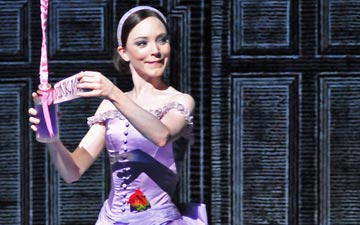

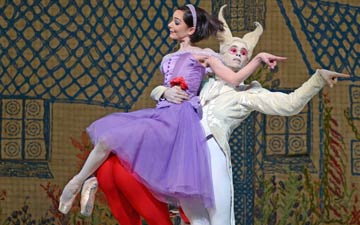
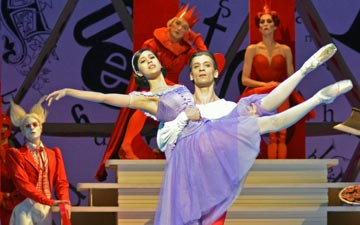
You must be logged in to post a comment.